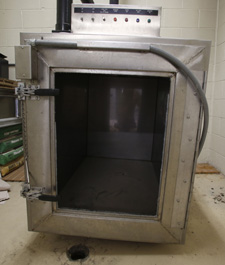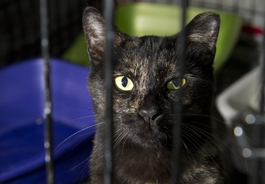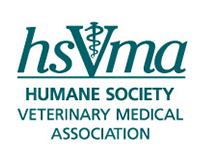| Advocacy |
Euthanasia via Gas ChambersOctober 22, 2014  Should gas chambers be considered an acceptable form of euthanasia? Jim Urquhart/AP Images for The HSUS When veterinarians are consulted regarding the use of a gas chamber for euthanization of animals in shelters, too often the answer is, “Yes, it is okay, because gas chambers are included in the AVMA Guidelines for the Euthanasia of Animals.”1 However, the guidelines state, “Intravenous injection of a barbituric acid derivative is the preferred method for euthanasia of dogs, cats, other small animals, and horses.” A careful read of the guidelines regarding carbon monoxide (CO) and carbon dioxide (CO2) gas chambers reveals some important information that should be considered when making a recommendation. The 2013 edition of the guidelines downgrades gas chambers from “acceptable” to “acceptable with conditions.” As explained by Dr. Gail Golab of the AVMA, “Techniques that are ‘acceptable with conditions’ may have a greater potential for operator error or safety hazard, are not well documented in the scientific literature, or may require a secondary method to ensure death. The use of these techniques requires that specific conditions be met to ensure that death is achieved in a humane way. When ALL of the conditions are met, ‘acceptable with conditions’ methods are equivalent to ‘acceptable’ methods.”2 Consequently, it is not advisable to support the use of gas chambers without knowing whether the “conditions for proper use” are being met. The “conditions” for use of a gas chamber in a shelter setting generally cannot be met for two reasons:
To the animals entering a shelter, it is a strange and unfamiliar environment that can be perceived as threatening. Thus, most animals in a shelter are not in a state of calm and relaxation that would be normal for them, for example, in a home environment or their natural habitat. In addition, many are physically ill or have been injured. Whether due to mental stress or physical abnormality, most animals in the shelter are compromised in ways that calls into question their ability to uptake gases at the proper rate to meet the “conditions” for a humane death. In these compromised states, the uptake and distribution of gases is not predictable. It is safe to assume that all wildlife is in a serious state of mental stress when presented to the shelter. Any gas that is inhaled must reach a certain concentration in the lungs at a controlled rate before it can be effective in achieving a humane euthanasia. When multiple animals are placed in a gas chamber it is close to impossible for each one to receive the proper dose at the proper rate. One’s placement inside the chamber will determine, in part, how much gas and at what rate it is received. It is a haphazard euthanasia experience that can be prolonged, painful, and ineffective. In stark contrast, euthanasia by injection of approved drugs can be done with a precision that ensures proper dosing, resulting in a humane death.  "Without doubt, euthanasia by injection is more humane than gas in a shelter setting." Julie Busch Branaman for The HSUS The excellent Euthanasia Reference Manual3 is a practical and comprehensive resource for veterinarians, euthanasia technicians, and others. It acknowledges, “No one wants to perform euthanasia, but people who take on this emotional and unwelcomed task owe it to the animals to do it well…. this manual serves as the definitive basic education tool for understanding the methods of humanely ending an animal’s life…” As expanded upon in the manual, pre-euthanasia drugs can be critical to a humane death. “Ideally, every animal scheduled for euthanasia could be gently restrained for direct IV or IP injection of sodium pentobarbital. However, in reality not every animal can be safely handled with gentle physical restraint, and in some cases animals are so unsocialized or fearful that attempts at physical handling would sharply increase their level of stress. For those animals, pre-euthanasia drugs should be administered to render them unconscious before the lethal injection of sodium pentobarbital. Availability of the proper pre-euthanasia drugs and proper training regarding their use are therefore integral to the success of any euthanasia protocol.” Veterinarians are reminded that we must help facilitate access to pre-euthanasia drugs when indicated to ensure a humane death. The manual also correctly points out, “No matter how frequently or infrequently euthanasia is performed in a facility, no other component of shelter work is as consequential or will be as carefully scrutinized by the public.” Without doubt, euthanasia by injection is more humane than gas in a shelter setting.  James Berglie for The HSUS James Berglie for The HSUSDr. Michael Blackwell has had a distinguished career in public service and as an educator. He was educated at Tuskegee University in Alabama, obtaining both a Bachelor of Science degree and a doctorate of veterinary medicine. After private veterinary practice, he took a post with the Food and Drug Administration’s Center for Veterinary Medicine. During his 20 years with the FDA, Blackwell served in both its human and veterinary medicine branches. From 1994 to 1998, Dr. Blackwell served as the chief veterinarian of the United States Public Health Service. In this role, he was the chief advisor to the Surgeon General of the United States. In 1997, he was promoted to the rank of Assistant Surgeon General (Rear Admiral) of the Commissioned Corps of the U.S. Public Health Service. Blackwell left the Office of the Surgeon General to become the dean of the College of Veterinary Medicine at the University of Tennessee in Knoxville. He led the college for eight years, during which he aggressively promoted the role of veterinary medicine in public health and also served as vice chair of the Pew Commission on Industrial Farm Animal Production from 2006 through 2008. He followed that experience by working to reorganize the animal shelter for the Knoxville region. He is currently the Senior Director of Veterinary Policy and chief veterinary spokesperson for The Humane Society of the United States. He also serves on the HSVMA Board of Directors. Read his full biography» REFERENCES
|
